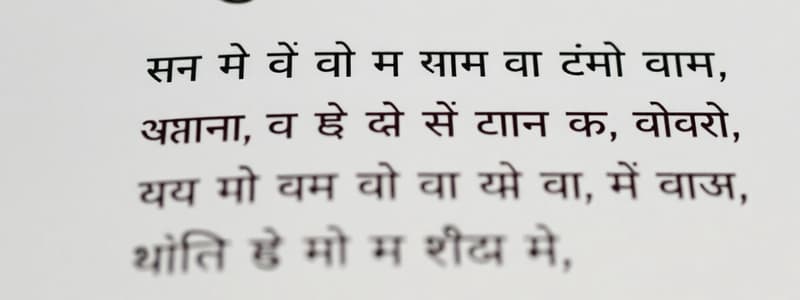Podcast
Questions and Answers
How did Pāṇini's work influence the development of Sanskrit?
How did Pāṇini's work influence the development of Sanskrit?
- It simplified Sanskrit grammar to make it more accessible.
- It promoted the use of Sanskrit in Buddhist texts.
- It established Vedic Sanskrit as the primary form.
- It standardized Classical Sanskrit, making it the dominant literary language. (correct)
Which feature is a characteristic of Sanskrit phonology?
Which feature is a characteristic of Sanskrit phonology?
- A rich inventory of sounds including aspirated stops and retroflex consonants. (correct)
- Absence of consonant clusters.
- Limited vowel sounds.
- Lack of diphthongs.
In what way do compound words (samāsa) contribute to the expressive capability of Sanskrit?
In what way do compound words (samāsa) contribute to the expressive capability of Sanskrit?
- They reduce the need for inflections.
- They enable the formation of long and complex expressions. (correct)
- They allow for the creation of concise expressions.
- They simplify sentence structure.
How does the use of Sandhi affect the pronunciation and writing of Sanskrit?
How does the use of Sandhi affect the pronunciation and writing of Sanskrit?
Which aspect of Sanskrit grammar is meticulously described in Pāṇini's Ashtadhyayi?
Which aspect of Sanskrit grammar is meticulously described in Pāṇini's Ashtadhyayi?
What role do the Ramayana and Mahabharata play in Sanskrit literature and Hindu culture?
What role do the Ramayana and Mahabharata play in Sanskrit literature and Hindu culture?
How has Sanskrit influenced modern Indo-Aryan languages?
How has Sanskrit influenced modern Indo-Aryan languages?
Which languages other than those of India have been influenced by Sanskrit?
Which languages other than those of India have been influenced by Sanskrit?
Why is Sanskrit still studied today, despite not being widely spoken?
Why is Sanskrit still studied today, despite not being widely spoken?
Which of the following is NOT a characteristic of Sanskrit as a highly inflected language?
Which of the following is NOT a characteristic of Sanskrit as a highly inflected language?
What distinguishes Vedic Sanskrit from Classical Sanskrit?
What distinguishes Vedic Sanskrit from Classical Sanskrit?
Which of these is a valid application of Sanskrit today?
Which of these is a valid application of Sanskrit today?
How does the understanding of Sanskrit contribute to fields like medicine, astronomy, and mathematics?
How does the understanding of Sanskrit contribute to fields like medicine, astronomy, and mathematics?
What role do the Upanishads and the Bhagavad Gita play within Sanskrit philosophical texts?
What role do the Upanishads and the Bhagavad Gita play within Sanskrit philosophical texts?
How does the Devanagari script connect Sanskrit to other languages?
How does the Devanagari script connect Sanskrit to other languages?
Which of the following best describes the structure of verbs in Sanskrit?
Which of the following best describes the structure of verbs in Sanskrit?
What are the primary functions of Sanskrit in contemporary society?
What are the primary functions of Sanskrit in contemporary society?
How does Sanskrit literature compare to scientific and technical texts in terms of subject matter?
How does Sanskrit literature compare to scientific and technical texts in terms of subject matter?
How do nouns reflect grammatical information in Sanskrit?
How do nouns reflect grammatical information in Sanskrit?
What is the significance of efforts to revive Sanskrit as a spoken language?
What is the significance of efforts to revive Sanskrit as a spoken language?
Flashcards
What is Sanskrit?
What is Sanskrit?
An ancient Indo-European language of India, dating back to the 2nd millennium BCE; primary liturgical language of Hinduism.
What is Vedic Sanskrit?
What is Vedic Sanskrit?
The earliest form of Sanskrit, found in the Rigveda hymns (1500-1200 BCE).
What is Classical Sanskrit?
What is Classical Sanskrit?
Standardized by Pāṇini in the 4th century BCE, became the dominant literary language.
Who was Pāṇini?
Who was Pāṇini?
Signup and view all the flashcards
What are the three genders in Sanskrit?
What are the three genders in Sanskrit?
Signup and view all the flashcards
What are the three numbers in Sanskrit?
What are the three numbers in Sanskrit?
Signup and view all the flashcards
What is Sandhi?
What is Sandhi?
Signup and view all the flashcards
What is Ashtadhyayi?
What is Ashtadhyayi?
Signup and view all the flashcards
What is Samāsa?
What is Samāsa?
Signup and view all the flashcards
What are the Ramayana and Mahabharata?
What are the Ramayana and Mahabharata?
Signup and view all the flashcards
What is the Devanagari script?
What is the Devanagari script?
Signup and view all the flashcards
Study Notes
- Sanskrit is an ancient Indo-European language of India, dating back to the 2nd millennium BCE.
- It serves as the primary liturgical language of Hinduism.
- Many classical Hindu philosophical and literary works are composed in Sanskrit.
- Sanskrit is also used in Buddhism and Jainism.
Historical Overview
- The earliest form of Sanskrit, Vedic Sanskrit, appears in the Rigveda, a collection of hymns composed between 1500 and 1200 BCE.
- Classical Sanskrit, standardized by Pāṇini in the 4th century BCE, became the dominant literary language.
- Sanskrit's influence spans South Asia, Southeast Asia, and parts of Central Asia.
- It has significantly influenced modern Indo-Aryan languages like Hindi, Bengali, Marathi, and Nepali.
Linguistic Features
- Sanskrit is highly inflected, featuring three genders (masculine, feminine, neuter).
- It uses three numbers (singular, dual, plural) and eight cases for nouns.
- Verbs are also highly inflected, indicating tense, mood, voice, and person.
- Sanskrit phonology includes aspirated and unaspirated stops, retroflex consonants, and various vowels and diphthongs.
- Sandhi, or phonetic combination, is crucial, altering word sounds based on their position in a sentence or compound.
Grammatical Structure
- Sanskrit grammar is detailed in Pāṇini's Ashtadhyayi, which provides comprehensive rules for the language.
- Nouns are declined by gender, number, and case, with different declension classes.
- Pronouns have distinct forms for personal, demonstrative, relative, and interrogative uses.
- Verbs are conjugated based on tense (present, past, future), mood (indicative, imperative, optative), voice (active, passive, middle), and person (first, second, third).
- Compound words (samāsa) are a prominent feature, enabling long and complex expressions.
Literature and Philosophy
- Sanskrit literature includes poetry, drama, prose, and philosophical treatises.
- Epics like the Ramayana and Mahabharata, are central to Sanskrit literature and Hindu culture.
- Classical Sanskrit drama, exemplified by Kalidasa's works, is known for sophisticated language and aesthetic sensibility.
- Philosophical texts, such as the Upanishads and the Bhagavad Gita, explore metaphysical and ethical questions.
- Sanskrit is the language of important scientific and technical texts covering medicine, astronomy, and mathematics.
Influence on Other Languages
- Sanskrit has profoundly impacted the vocabulary and grammar of many Indo-Aryan languages.
- Loanwords from Sanskrit are found in religion, philosophy, science, and literature within these languages.
- The Devanagari script, used for Sanskrit, is also used for Hindi, Marathi, and Nepali.
- Sanskrit's influence extends beyond India, with loanwords and grammatical structures in Southeast Asian languages like Thai, Khmer, and Indonesian.
Sanskrit Today
- While not widely spoken like modern languages, Sanskrit is studied and used in traditional contexts.
- It is taught in universities and Sanskrit colleges globally.
- Sanskrit is used in Hindu rituals, prayers, and chants.
- Efforts to revive Sanskrit as a spoken language have had varying success.
- Studying Sanskrit provides insights into India's history, culture, and philosophy.
Studying That Suits You
Use AI to generate personalized quizzes and flashcards to suit your learning preferences.




